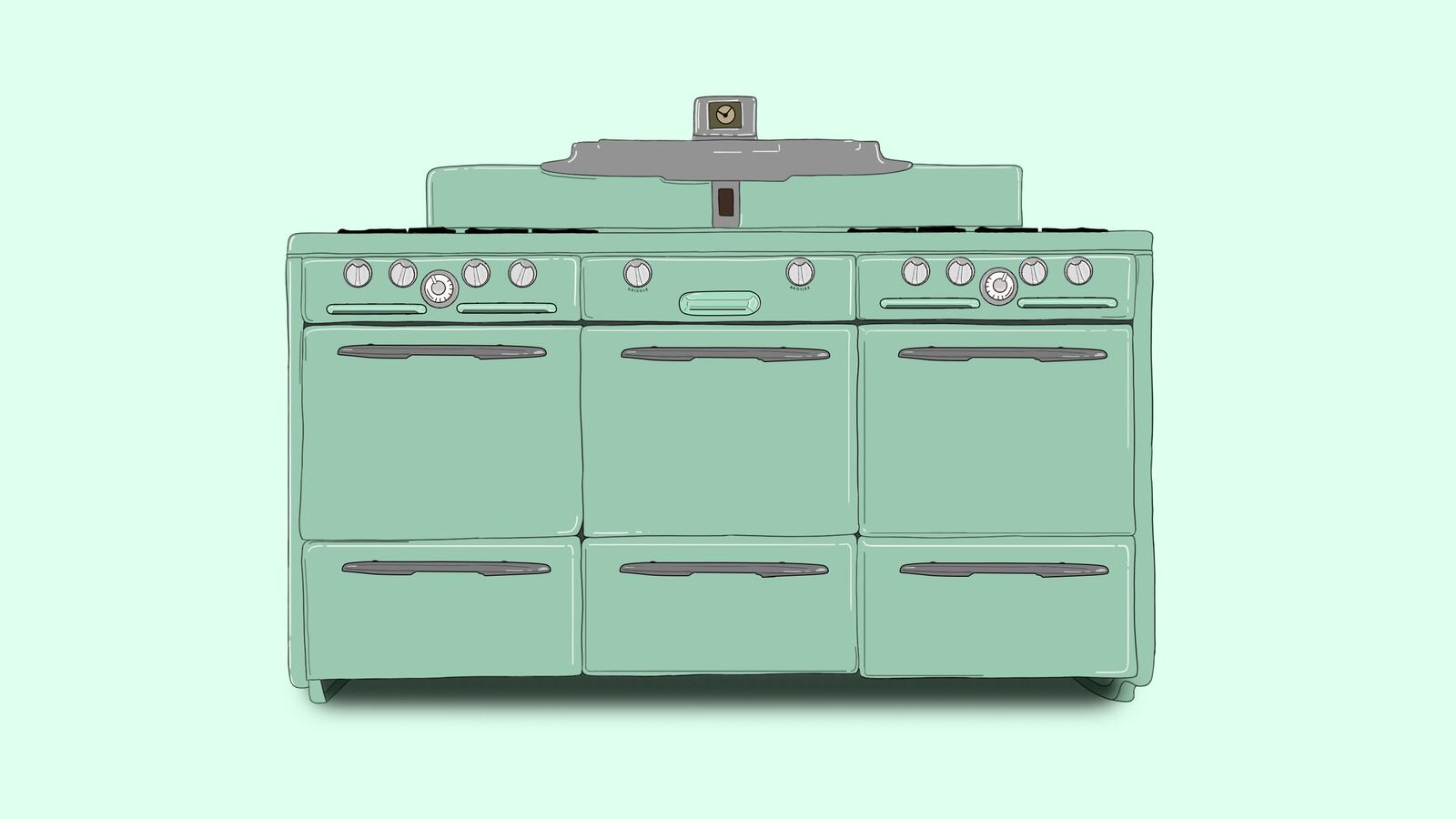Two brothers who make a living messing around in the kitchen inevitably find themselves competing for real estate at a four-burner gas range. Believe us, we’re not stove snobs, we don’t require special “features” or impressive BTUs, and the 265 recipes in our first cookbook (that garnered two James Beard Awards and two IACP awards) were developed on a four-burner Magic Chef that our landlord installed.
But still, the idea of working on a stove with some elbow room was a fantasy of ours.
So, when we learned about the rare “Town & Country” model produced in the late 1940s by Roper, in Rockford, Illinois, we took note. A full five-feet wide, the stove has four burners over here and another four over yonder, with a sheet-pan-sized aluminum griddle in between. Three oven doors march across the front—one concealing a large broiler—and, in fact, there are three broilers total on this rig. It has the pragmatism of a bicycle built for two, the chrome-plating of a 1950s Cadillac, and the ridiculous bravado of Howard Hughes’ Spruce Goose. We had to find one.
After a couple years searching, we located an unrestored example near the Jersey Shore. It had baked many a ziti over the years, according to Fulvio Figliano, who purchased the house and stove from the original owner. Its enameled hood ornament still gleamed, most of the burners were still operational, but he was ready to part with it—in fact, his wife was insisting it had to go.
We paid just under $2,000 for the Town & Country—we probably should have haggled more—plus the cost of a truck rental and a few herniated discs getting it to our test-kitchen in Matt’s home. A stove this large has its own field of gravity—it weighs almost 1,000 pounds and requires four people (minimum; seven preferable) to move once it’s raised onto dollies. After an epic loading and unloading (we fashioned plywood ramps with cinderblock supports to get it down and up short flights of stairs) it sat in the dining room for two years while we figured out our next steps. It functioned beautifully as a conversation piece but remained stone cold.
There’s a peculiar economics to old stove recycling and restoration, thanks to the extreme difficulty of moving that much steel around: location is everything. Nestled snugly between cabinetry in a Penobscot kitchen, far from a restoration shop, a big ol’ stove is worth barely more than its scrap-metal cost; one that’s dollied inside a moving truck on I-95 commands quite a bit more, but still requires a skilled renovation, the installation of modern safety valves (which prevents gas flow if a pilot light blows out), new thermostats and pilots, and the replacement of insulation, to render it safe, legal, and comfortable to operate.
Depending on the model and desirability, a mint condition, fully-restored specimen from the middle decades of the 20th century, crated for shipping, is worth about $5,000 to $20,000. (Rachel Ray’s daisy-yellow 1950 Chambers 90c might run you about $7,000 before shipping.) As modern appliances have become more plastic and disposable, stove restorers have all but disappeared, but a small subculture has survived, much of it just beneath the radar of the web.
We found our stove restorer, David Erickson, by word-of-mouth through an architect friend, and we conscripted neighbors and relatives to help dolly up the Roper again and load it on a trailer. We towed it to Littleton, Massachusetts, where Erickson operates out of an old train station, and, with his assistance, deposited “her” in a yard filled with cast iron carcasses and parts.
Almost a year later, in the spring, we paid a surprise visit to Erickson. He wasn’t there, but the stove was in the exact same place we’d left it, rusting, its condition headed downhill. So when, that August, he called to announce the Town & Country’s completion, we were incredulous.
“It runs like a friggin’ Ferrari,” he said, in an accent familiar to fans of the NPR radio show Car Talk. All we’d need to pick it up was a certified check for $7,650—90 hours at $85 dollars an hour. Ouch. Oops. We played it cool and told him we’d call him back with a date for the pick-up.
A few days went by as we reckoned with this unforeseen crater in our path. Why did we think the cost of restoration would be less than the cost of the stove? Why didn’t we ask for an estimate? Would we ever have done this if we knew the final cost? We swallowed hard, and dug into lines of credit, trying to remind ourselves that the value of the stove, if and when it could be sold, might justify the expenditure.
When we picked the Roper up, Erickson, the two brothers who work with him, and the entire shop were covered in soot. But in the gloom of the station the Town & Country glittered white and silver. We crouched down, peering into the thing as Erickson lit the safety pilot beneath one oven, and, a few seconds later, the oval iron manifold erupted in a synchronized halo of blue flame. We flat-bedded the stove back to the house, and with the assistance of three strong, patient, and ever-reliable friends, loaded it back into the kitchen.
The appliance is Howard-Hughes luxurious. We each have our own complete range, with a spare broiler and griddle to share. First, we slow-roasted a pork shoulder for tacos and found the griddle in the middle to be broad enough to toast nine tortillas at a time. Erickson called a week later to see how “she” was performing, and we happened to be cooking red-pepper lasagnas—four of them, two in each oven. We replied that we were impressed—thrilled, even—but couldn’t resist asking: what if we ghosted on you, if we couldn’t pay the bill?
“When you didn’t call back at first, I thought I was gonna have to load it into the van and take it to Brimfield,” he said, referring to the large outdoor antique show in New England. “I coulda gotten fifteen grand there easy—in, like, the first five minutes.”
We broil briskly and evenly these days, Matt over there and Ted over here, with plenty of room to share with another person or two in the middle. The Roper Town & Country does seem to have a gravitational pull on people, which is a good thing because we may have to open a cooking school to pay for it.

